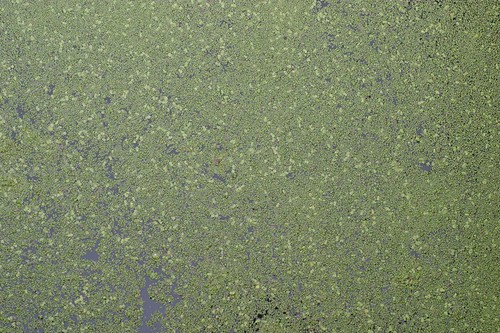The Solution to Our Energy Woes? Pond Scum
 So says CNN:
So says CNN:"Algae is the ultimate in renewable energy," Glen Kertz, president and CEO of Valcent Products, told CNN . . . . Algae are among the fastest growing plants in the world, and about 50 percent of their weight is oil. That lipid oil can be used to make biodiesel for cars, trucks, and airplanes. . . .
Kertz said he can produce about 100,000 gallons of algae oil a year per acre, compared to about 30 gallons per acre from corn; 50 gallons from soybeans.
Before you get too excited:
Using algae as an alternative fuel is not a new idea. The U.S. Department of Energy studied it for about 18 years, from 1978 to 1996. But according to Al Darzins of the DOE's National Renewable Energy Lab, in 1996 the feds decided that algae oil could never compete economically with fossil fuels.
But . . .
The price of a barrel of oil in 1996? About 20 bucks!
Image by Robert Meike (flickr)









8 Comments:
A five minute calculation by a high school sophomore science student can show that algae as a means to mitigate CO2 emissions from coal fired power plants is not feasible. There is simply not enough energy per square meter, and the cost of collection surface per square meter is too high to justify this scheme. Anyone who promotes this scheme should present the math and science behind it, including algae yields, CO2 sequestered per square meter, and cost of CO2 removal from stack gases, cost of the array of collection devices, and detailed analysis of what to do with the algae. It is easy to say algae sequesters CO2 (of course it can and does) but for it to be useful as a process, the engineering feasiblity numbers must be presented. Any engineer who has looked at this has come to the conslusion that it is not feasible.
You realize, of course, that the numbers aren't static? Costs begin high when a new technology is in development, and they fall as production begins. So your high school sophomore would not have any reasonable estimate of the actual cost basis, nor would you. If the numbers already added up, they'd already be doing it. But since the numbers are changeable, the idea here is to see if the process can be improved to the point where it does add up. If we insist that a new technology proves its economic viability before we develop it, we'd never develop anything - ALL new technologies appear cost-prohibitive at first. Then, over time, we figure out how to do it cheaper. Your high school sophomore would never predict that, which is why I'm glad she's not in charge of new development. 100,000 gallons of oil per year per acre is certainly not 'too small of a yield per square meter'! That's 50-100 cars/acre, or about 20 million acres to run 500 million vehicles. (total US farmland = 974 million acres) It sounds like a lot of land but it's absolutely, positively do-able when the costs can be brought in line.
Sorry, 80 million acres. But you caught that already. Where's a high school sophomore when you need one?
also think about the fact that you don't have to put these plants on the farmland, if they are self contained you could potentially put them any where like the one in texat that is in the desert ont on farmland
Why do we have to use farm land to grow the algae? Why can't we start using ocean real estate? Reel huge sheets of algae in when they are ripe and have pillars of algae as high as the human farms in the matrix? Honestly, we could always build vertically instead of horizontally, perhaps sky scraper height algae farms anyone?
The thing I like about this idea is that it is not only utilizing solar energy vis a vis photosynthesis but also relying on that underlying biological chemistry to generate useful, stored energy. brilliant
This latest algae scheme uses greenhouses which could be constructed any place that gets a lot of sun. No need to use existing farmland, and I believe the required
water gets recycled. It all comes down to
the ongoing cost of the plastic containers which won't last forever, and the one-time cost of greenhouse construction. Anything but a sure thing. I have bought their stock but view it as a
30-1 longshot, just like any other penny stock.
By the way, the 100,000 gallons per acre per year
is an exaggeration. The material available to investors on line states something around 33,000 per year,
with hints that the yield could be increased as they
find better algae.
I was talking about this six years ago and couldn't get the government or big business to listen! Green Fuel Technologies has been around doing this and no one listens!
Post a Comment
<< Home